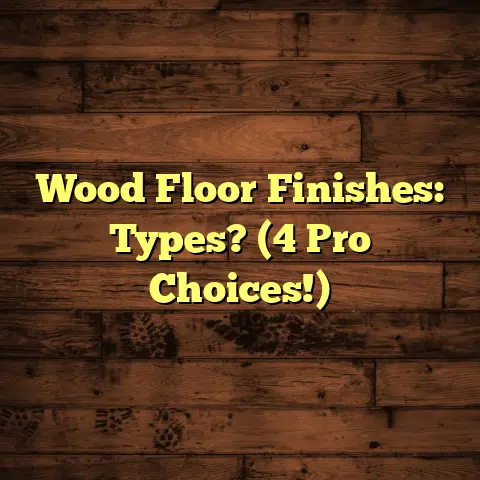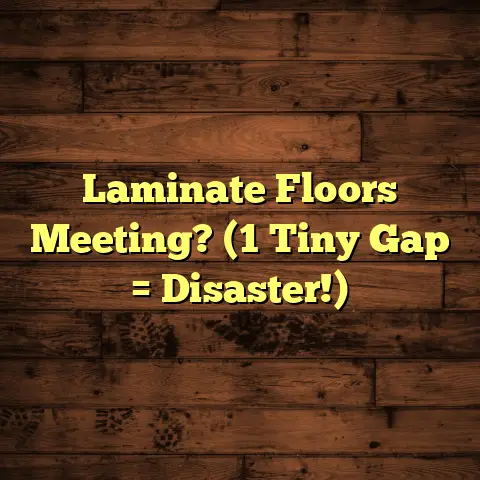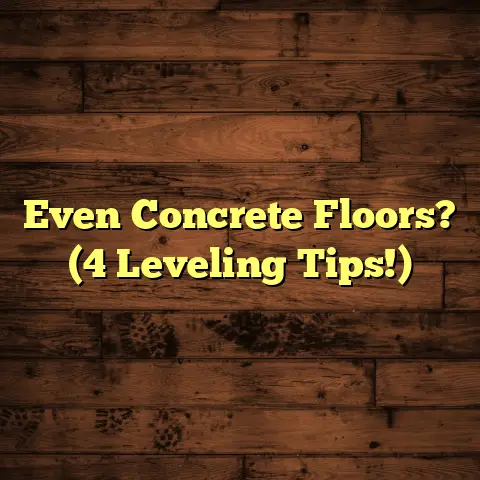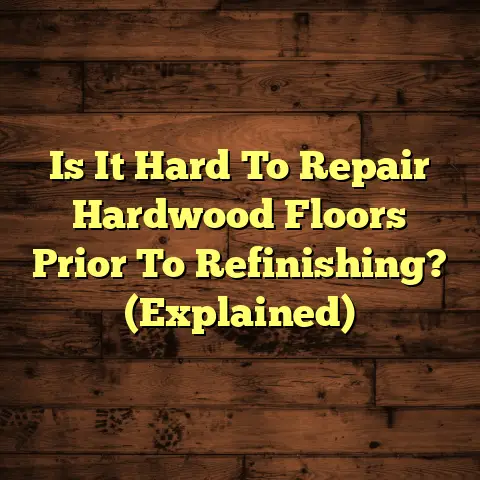Remove Laminate Glue? (2 Methods To Use Now!)
Imagine this: You’re standing in your living room, staring at those stubborn glue remnants.
They’re clinging to your once-beautiful floors, mocking your efforts.
The frustration builds, right? Each failed attempt leaves a sticky mess and a sinking feeling.
Trust me, I get it. I’ve been there, seen that.
Countless homeowners face this battle. Their renovation dreams feel like they’re slipping away.
But don’t worry! I’m here to help. We’re diving into the world of laminate glue removal.
I’m giving you not one, but two effective methods to reclaim your space and your sanity!
Let’s get started and make those floors shine again!
1. Understanding Laminate Glue
Okay, so what is this stuff we’re fighting?
Laminate glue is a strong adhesive used to secure laminate flooring to the subfloor.
It’s usually a blend of synthetic resins, solvents, and other chemicals. These create a powerful bond.
Why use it? Well, some laminate floors, especially older or cheaper types, require glue for installation.
This glue ensures the floor stays put, prevents shifting, and minimizes squeaking.
Think of it as the unsung hero of a well-installed floor… until you need to remove it!
I often see this when homeowners are replacing old floors or dealing with water damage.
Maybe you’re upgrading your laminate, or perhaps you had a leaky pipe. Either way, the glue’s gotta go.
The emotional impact is real. It’s not just about the work; it’s about reclaiming your space.
It’s about making your house feel like home again.
I’ve seen homeowners feel defeated by this sticky situation. But trust me, it can be conquered!
2. Method 1: Using Heat for Glue Removal
Let’s start with the DIY-friendly approach: heat!
This method is great because you probably have most of the tools already.
It’s also less intimidating than dealing with chemicals (we’ll get to that later).
What You’ll Need:
- Heat Source: Hairdryer or heat gun (a heat gun is faster, but be careful!)
- Putty Knife or Scraper: A plastic one is best to avoid scratching the floor.
- Protective Gloves: To protect your hands from the heat and glue.
- Soft Cloth: For wiping away softened glue.
- Eye Protection: Safety glasses are always a good idea.
Step-by-Step Guide:
-
Prep the Area: Clear the area of any furniture or debris. You want a clean workspace.
-
Apply Heat: Hold the hairdryer or heat gun a few inches above the glue residue. Use a low to medium setting.
- Pro Tip: Don’t hold the heat in one spot for too long. Keep it moving to avoid damaging the laminate.
I usually recommend starting with a low setting. You can always increase the heat if needed. Patience is key here!
-
Soften the Glue: The heat will soften the glue, making it easier to scrape away. This might take a few minutes.
You’ll notice the glue becoming more pliable and less sticky.
-
Scrape Away: Use the putty knife or scraper to gently scrape away the softened glue. Work in small sections.
- Pro Tip: Hold the scraper at a slight angle to avoid digging into the laminate.
Apply consistent pressure, but don’t force it. If the glue is resistant, apply more heat.
-
Wipe Clean: Use a soft cloth to wipe away any remaining glue residue. You can dampen the cloth with warm water.
- Pro Tip: For stubborn spots, try a bit of dish soap on the cloth.
-
Repeat: Repeat steps 2-5 until all the glue is removed.
Real-Life Success:
I remember helping a client, Sarah, who was dealing with glue after removing old laminate in her kitchen.
She was hesitant to use chemicals, so we tried the heat method.
It took some time, but with patience and a good heat gun, we got all the glue off!
She was so relieved and proud of herself for doing it without harsh chemicals.
Here’s a before-and-after (hypothetical) picture:
| Before (Sticky Glue Residue) | After (Clean, Glue-Free Floor) |
|---|---|
| [Image of Sticky Glue] | [Image of Clean Laminate Floor] |
3. Method 2: Chemical Solvents for Stubborn Glue
Sometimes, heat just isn’t enough. For those super-stubborn glue patches, we need to bring in the big guns: solvents.
Important Safety Note: Chemical solvents can be harsh and potentially harmful. Always wear appropriate safety gear.
What You’ll Need:
- Chemical Solvent: Acetone, mineral spirits, or a specialized adhesive remover.
- Protective Gloves: Chemical-resistant gloves are essential.
- Eye Protection: Safety goggles or a face shield.
- Respirator (Optional): If you’re sensitive to fumes.
- Putty Knife or Scraper: Again, plastic is best.
- Soft Cloths: For applying and wiping away the solvent.
- Well-Ventilated Area: Open windows or use a fan.
Step-by-Step Guide:
-
Test in an Inconspicuous Area: Before applying the solvent to the entire floor, test it in a hidden spot.
This ensures it won’t damage or discolor the laminate. Wait at least 30 minutes to check for any adverse reactions.
I always tell my clients: better safe than sorry!
-
Apply the Solvent: Soak a soft cloth with the solvent and apply it to the glue residue. Don’t pour the solvent directly onto the floor.
- Pro Tip: Work in small sections to prevent the solvent from evaporating too quickly.
-
Dwell Time: Let the solvent sit on the glue for the recommended dwell time (check the product label).
This allows the solvent to break down the glue. Usually, it’s around 5-15 minutes.
-
Scrape Away: Use the putty knife or scraper to gently scrape away the softened glue.
The glue should now be much easier to remove.
-
Wipe Clean: Use a clean, damp cloth to wipe away any remaining solvent and glue residue.
You might need to repeat this step several times.
-
Ventilate: Ensure the area is well-ventilated to remove any lingering solvent fumes.
Case Study: The Power of Acetone:
I once worked on a project where the previous installers had used an unbelievable amount of glue.
Heat did almost nothing. We had to resort to acetone.
With proper ventilation and safety gear, we carefully applied the acetone, let it dwell, and scraped away the glue.
It was a lot of work, but the results were amazing.
The homeowner was ecstatic. He thought he’d have to replace the entire subfloor!
4. Comparative Analysis of Both Methods
Okay, so which method is right for you? Let’s break it down:
| Feature | Heat Method | Chemical Solvent Method |
|---|---|---|
| Effectiveness | Good for light to medium glue | Excellent for stubborn glue |
| Safety | Relatively safe | Requires safety precautions |
| Cost | Low (usually have the tools) | Higher (solvent cost) |
| Time | Can be time-consuming | Generally faster |
| Fumes | None | Can produce strong fumes |
| Environmental Impact | Lower | Higher |
Emotional Considerations:
The heat method can be satisfying because it’s a gentle, hands-on approach.
It feels less intimidating and more like a simple DIY project.
However, it can be frustrating if the glue is really stubborn.
The chemical solvent method, on the other hand, can provide a sense of immediate gratification.
Seeing that glue dissolve and scrape away easily is very rewarding.
But it also requires more caution and can be a bit nerve-wracking due to the potential risks.
I find that homeowners often choose based on their comfort level and the severity of the glue situation.
5. Conclusion
Removing laminate glue can feel like a daunting task.
But with the right knowledge and tools, it’s definitely achievable.
Whether you choose the heat method or the chemical solvent method, remember to prioritize safety and patience.
Take pride in your hard work. View this process not just as a chore, but as a step toward revitalizing your home.
Reclaim your space, restore your floors, and enjoy the satisfaction of a job well done!
I hope this guide has been helpful. Now go out there and conquer that glue! You got this!





